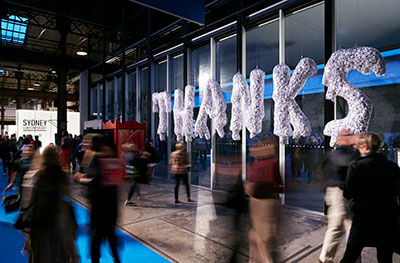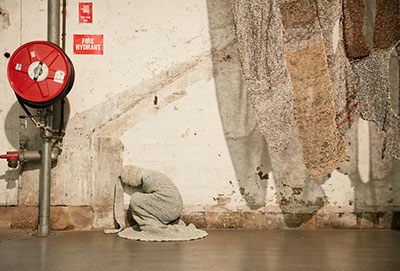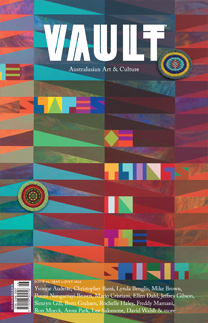Sydney Contemporary:
A constructive criticality

Image credit: Michael Lindeman, Thanks, 2018, rejection letters, clear vinyl, decals. Installation view, Sydney Contemporary, 2019. Courtesy the artist and Sullivan+Strumpf, Sydney|Singapore. Photo: Zan Wimberley
In the politest of entrances, Sydney Contemporary 2019 welcomed audiences and galleries with Michael Lindeman's work Thanks (2018). A series of clear vinyl letters, shaped by a rough stuffing of thousands of scrunched paper rejection letters, the work spanned more than 3 metres horizontally to spell the word Thanks. Hung across the entrance window of Sydney's spectacular Carriageworks, the gesture seemed an obvious nicety, a humorous intervention and an homage to the energy and effort involved in the production of Australia's largest art fair. In offering the phrase Thanks, Sydney Contemporary had here pre-empted the fair's success.
In Lindeman's typical wry institutional critique, his work, strategically positioned upon entry, illuminated critical debates around the function of art fairs such as this and the commercialisation of contemporary art in these settings. This work speaks to the fundamental and often inherent frustrations of being an artist, namely, the rigour and rejection involved in practice. The irony is, of course, that this work participates in the very commodity culture that it aims to critique, at once provocative and ineffective in the immediate environment of Sydney Contemporary, a fair that relies on the selection, rejection and participation of both Australian and international artists and their commercial galleries. Like all the artists presented at Sydney Contemporary, Lindeman must participate in the economy to fuel the cycle of funding, exhibiting and selling that affords a sustainable career. This is the underlying tension at play throughout the fair, further teased out by Installation Contemporary, a sub-section of the fair that took the form of a series of large-scale works curated throughout Carriageworks by Director of 4A Centre of Contemporary Asian Art, Dr Mikala Tai. Tai's curatorial vision, with its welcomed sense of critically, sat alongside the individual ambition of each galleries presentation to force audiences to consider: Who benefits from these events? And how do fairs contribute to this economy of exchange?
Installation Contemporary offered an opportunity for large-scale works across a range of media to be exhibited outside of the conventions of the booth, even if the costs of proposal, production and installation were to be absorbed by artists and gallerists. Tai curated a selection of both Australian and international artists with the intention to represent the layered sense of strength, diversity and criticality demonstrated in practices from the global South. Not only did the placement of works by Kolkata-based Rathin Barman, Sydney-based Consuelo Cavaniglia and Sydney-based Yioryios Papayioryiou, amongst others, disrupt and disperse the social footprint throughout the mammoth Carriageworks warehouse, it presented an opportunity for selected artists to exhibit work of scale to a specific, ready-made and engaged audience.
A particular highlight of this fair's iteration was artist Movana Chen's Dreconstructing (2004-present), an ongoing project in which Chen knits together shredded magazines. The act of deconstructing and then reconstructing particular sets of languages into the form of a universal lattice here offers an opportunity for conversation and global exchange. The quilt, standing more than 5 metres tall, perfectly occupied one of Carriageworks central chambers. In its muddied, universal earth tones, the distinctiveness of each magazine dissolved to serve a grander gesture of community and connectedness. Whilst the work faded somewhat into the internal brick of the historic building – serving as a subtle moment of critical reflection – it was activated by Chen's performance on the fair's opening night. In an effort to deactivate the chatter and bustle of one of the events busiest bars, Chen embodied her Body Container (2019), produced as part of the Sydney Contemporary and Artspace International Artist in Residence Program, of which Chen was the inaugural recipient. An earlier version of the work was displayed static and sculptural at her representative Flower Gallery, London and New York. In reptilian style, Chen's slight figure attempted to interrupt the pace of opening night proceedings, however, in true art fair style the unspoken cultural behaviours of any museum were abandoned for raucous ambivalence.

Image credit: Movana Chen, Dreconstructing, 2004-ongoing, knitted shredded magazines, 550 x 450 cm. Installation view, Sydney Contemporary, 2019. Courtesy the artist, Flowers Gallery, London, New York. Photo: Zan Wimberley
Other Installation Contemporary highlights include Jess Bradford's Haw Par Villa - Video Snapshots series (2016-2019) a bamboo scaffolding that formed the foundation for a looping single-channel video across a number of screens. The project took a cultural theme park as its case study. Privately built in Singapore in the 1930s by the Burmese-Chinese brothers behind the medicated ointment ‘Tiger Balm', the theme park led to an interrogation of cultural, national and personal identity. Another highlight, Katie West's Clearing (2018-19), offered a meditative enclave comprised of naturally dyed textiles arranged in the form of a conversation circle. In West's natural dyeing process, undertaken across both Wurundjeri and Gadigal country, Clearing contributes to global discourse surrounding the climate emergency by positioning voices of Indigenous artists, activists and academics at its centre.
The 2019 cohort of exhibiting galleries saw Sydney Contemporary expand internationally with increased representation by galleries from Africa and Asia. Gisborne-based gallery PAULNACHE's presentation of Oliver King's photographic collages offered the humour and fun that the seriousness of art fairs often overlooks. A series of King's larger than life dismembered male legs stood proudly in one of the fairs central corridors. With titles like Some people say I drink too much (2019) and I don't give a shit about you. Success smells fantastic (2019) the artist's work offered an ironic jab at the glitz and glamour of contemporary art's fastest growing exhibition model. More than the shock of hairy, bare legs was the uncanny resemblance between image and audience. In the collage of neon coloured material and fixed collared shirts sat a reflection of those on the other side. This mirroring of audience, artist and subject offered a momentary fright, a forced consideration of the conditions from which artists participate, audiences engage and galleries deal in the global art ecology.
Other notable highlights included the work of Nadia Herdández at Blackartprojects, recent winner of the Churchie Emerging Art Prize; the formidable and physical paintings of Newcastle-based Lottie Consalvo, represented by Dominik Mersch; Eric Bridgeman's shield paintings at Gallerysmith; and the strength of First Nations artists felt throughout, namely the work of the Tjanpi Desert Weavers at APY Gallery and Tiger Yaltangki's graphic paintings at Alcaston Gallery . Perhaps lacking the attention and gravitas they deserved were first time presentations by a select group of galleries representing the global South: Yavuz Gallery debuting to mark the opening of their new Sydney space; Loko Gallery, MA2 Gallery and COHJU Contemporary Art, all hailing from Japan. Whilst their presentations were formidable, these galleries were not architecturally centred within the fairs defined layout, missing an opportunity to mimic the staunch pre-fair promotion of their inclusion and expand global contemporary art histories.
Ultimately, Sydney Contemporary 2019 succeeded in its diversification of participating galleries, the centring of artistic practice and the invitation of critical dialogue strategically introduced throughout the program. Most importantly, the inclusion of large-scale projects and satellite events welcomed a criticality that enabled the fair to be both economically effective and discursively constructive, contributing to a broader discussion surrounding the sustainability of contemporary art practices and exhibition models.
sydneycontemporary.com.au@mikalatai
sullivanstrumpf.com
jessbradford.com
flowersgallery.com
stationgallery.com.au
curatorialandco.com
paulnache.com
dominikmerschgallery.com
artereal.com.au
... Subscribe






















